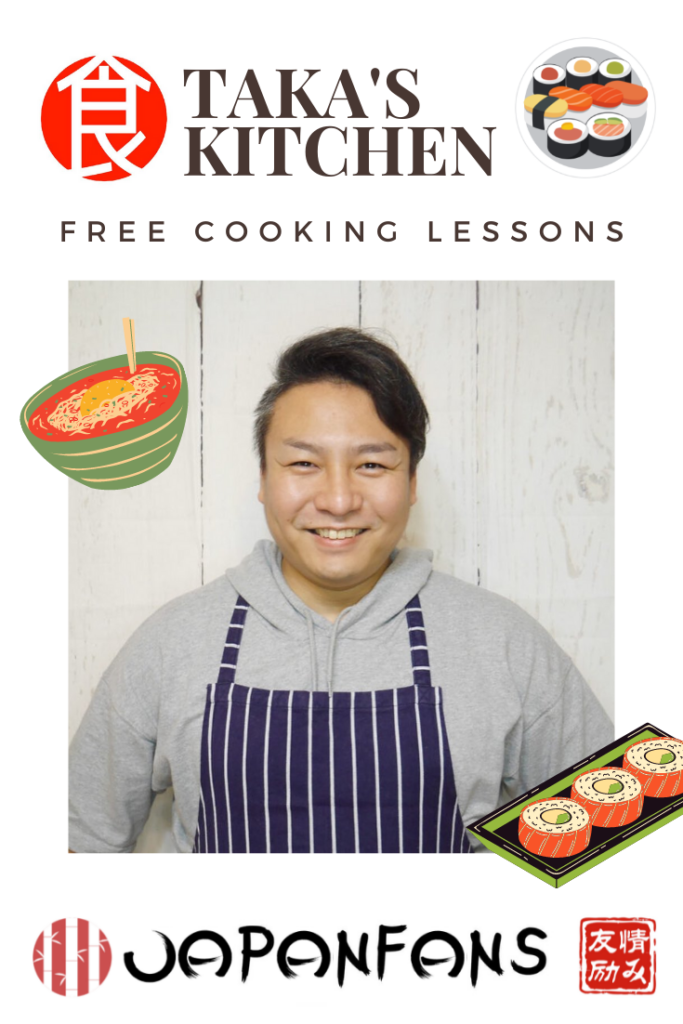The Japan Fans have enthusiastically started working with Taka’s recipes! And in this blog post, we share some new free cooking lessons by him, from his channel “Regional Food Japan”. Thank you, Chef Taka!
Oh and remember Shojin Ryori? With some minor adjustments, all recipes are also easy to make vegetarian and vegan. Enjoy – and don’t forget to share the pictures of your cooking results with us in our Facebook group! ^_^
Did you like the modern version of tonkatsu that Sanne taught us? Then you will love the video below… here, chef Taka shares a more authentic recipe for KATSU DON with Miso Sauce. It is part of his new “Donburi series of Regional Food Japan”. As he explains it: “Donburi (or Don) is one of the icons of Japanese cuisine. Famous examples would be Katsu-Don(Fried pork cutlet and egg over rice), Gyu-Don(Sliced beef and onion over rice) and Oyako-Don(Chicken and egg over rice). A Donburi simply consist of freshly steamed rice and a topping/toppings over it and served in a bowl called Donburi. There’s no other rule as long as they are served in a Donburi. So, guys, be creative and try out your own versions, or otherwise, explore traditional Donburi. Hope you enjoy.”
The next Donburi recipe is with avocado, mushrooms and eggs and, according to our chef Taka, ’tis “perfect for a weekend’s breakfast or brunch”. Watch the video and cook it together with Taka:
The next cooking video will probably make you smile, as the recipe is called “Turn BARGAIN STEAK into a DELICIOUS JAPANESE STEAK-DON with Home-made Japanese Steak Sauce” by chef Taka. Sounds like an awesome trick to “Japanize” the vegetarian and vegan “steaks” that are available in the supermarket! Let’s try it out.
The next freely available cooking lesson by chef Taka is a recipe for “Hokkaido’s FRIED SQUID LEG RICE BOWL (Geso-Don) with Sweet Soy Sauce”. Enjoy!
Not in the mood for a Don? Then why not try Taka’s “Tokyo’s traditional DELICIOUS & EASY TUNA HOT POT”…? As the cheft explains: “Negi-Ma Nabe is a hotpot with tuna and green onion enjoyed in Tokyo since 1800’s. “Negi” is translated as green onion or leek and “Ma” is the acronym of “Maguro”, which means tuna. Unlike today, people in Edo, an old name of Tokyo, were not fond of eating Toro (a fatty tuna bell) and used to throw it away, but thanks to their creativity, they eventually came up with the way to enjoy it as a hotpot so that the cut does not get wasted. Addition of Negi toned down the fishiness of Toro and made it into a delicious and beloved dish.”
Another tasty recipe that could easily be adjusted for vegetarian and vegan eaters, is Taka’s version of the “Hokkaido’s Original Karaage Recipe” – or, as he calls it “Zangi with a special dipping sauce”.
“This dish originally started to be served in a city called Kushiro, an important port city in eastern Hokkaido”, explains Taka on his YouTube. “Unlike other types of Japanese fried chicken, the original version from Kushiro comes accompanied with a Worcestershire sauce based sweet and savoury dipper. The fried chicken itself is already super good but the sauce enhances it like ten times!! You can also enjoy different cuts of chicken.”
As a bonus, we’d also like to share Taka’s special celebration video. To quote him once more: “Thanks a million for watching my video and helping my channel reach 500 subscribers. This is a special video to commemorate the reaching. Taking this opportunity, I’d like to introduce five Japanese recipes using one of the luckiest ingredients in Japanese cooking. I hope you enjoy!”
Click here for the first blogpost with free cooking lessons by chef Taka – from his YouTube Channel “Regional Food Japan”. And if you like these blog posts, you can share them by using the image below. Happy cooking!

